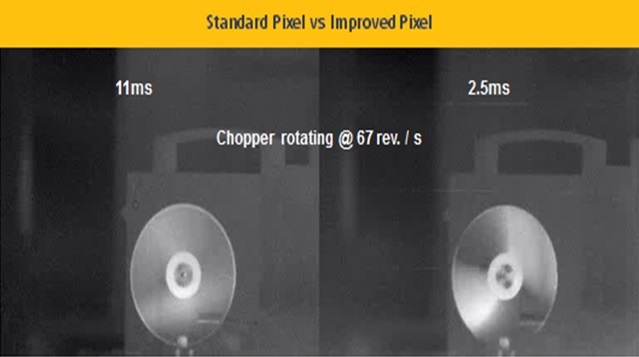Veurey-Voroize, near Grenoble, France, April 10, 2018 – ULIS, a designer and manufacturer of the widest range of thermal image sensors for commercial, defense and security applications, today announces it has achieved unmatched performance with its bolometer (a type of thermal sensor) that now meets speeds of fast imaging applications. It has gained a response time that is four-times greater than standard bolometers. ULIS has achieved this faster speed without any trade-off in sensitivity; the company is the first to overcome this technological challenge in its aim to significantly raise the overall Factor of Merit (FoM) of bolometers. FoM, a relative measure of thermal sensor sensitivity against response rate, is a key parameter camera makers use to compare the performance of thermal sensors.
In contrast to standard bolometers, ULIS’ quicker response time means that it can detect fast moving objects without producing a blurred image. This new pixel technology enhancement, in conjunction with the bolometer’s comparably lower price, make it ideal for inclusion in machine vision cameras, where high frame rates for in-line quality inspection are required but previously the cost of adopting thermal imaging had been prohibitive. The bolometer will also have wider application in defense, such as missile warning systems.
“ULIS is thrilled with the outstanding results we have achieved in improving both the response time and sensitivity of the bolometer. This is proof of the continued strength of our affordable pixel technology and the skillset within our R&D teams,” said Sébastien Tinnes, marketing team leader at ULIS. “We feel camera makers will benefit tremendously from thermal image sensors, which, when used in conjunction with visible or SWIR cameras, can provide valuable additional information on product quality. We look forward to exploring with customers, industrial partners and the scientific community attending SPIE Defense and Commercial Sensing in Orlando in mid-April, the potential of integrating this new pixel technology into future equipment requiring fast imaging capabilities.”
ULIS’ new pixel technology achieves an FoM of 125 to 150mK.ms, enabling sharper images that aim to improve the quality of in-line production controls, such as automated glass manufacturing line monitoring.
ULIS presented its results in a technical paper entitled: ‘ ULIS Bolometer for Fast Imaging Applications Sets New Response Time Record’ at OPTO2018 in Paris. They showed gains in FoM performance from the standard NETD=50mk multiplied by TTC=10 to 12ms (meaning FoM 500 to 600mK.ms) to a new level of NETD=50mK multiplied by TTC=2.5 – 3ms (meaning FoM 125 to 150mK.ms), a four-fold improvement.
During SPIE DCS 2018, April 15 – 19, ULIS will be exhibiting at the Sofradir Group booth #806.
About the Factor of Merit (FoM)
FoM is a parameter that combines sensitivity (NETD) and response Time (TTC). Response time measures how quickly the bolometric pixel membrane responds to the infrared radiation changes taking place. Sensitivity determines how well the sensor can detect an object in all-lighting conditions, as well as in complete darkness. Both sensitivity and response time are linked. Traditionally, they move in counterproductive directions; reducing the response time tends to degrade sensitivity.

ULIS sets new performance record for bolometers; now match speeds of high frame-rate cameras
ULIS bets on faster design and inherent lower cost of bolometers (thermal sensors) to increase attractiveness of thermal imaging for machine vision

Standard Pixel vs Improved Pixel











